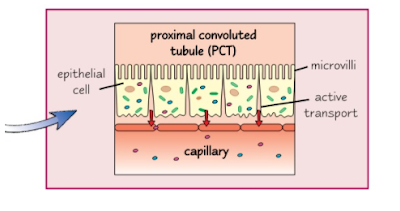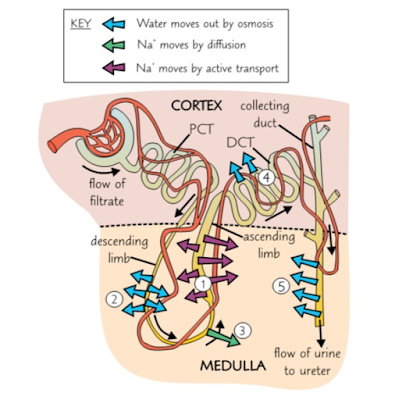- Nephron filtering the blood -
- Blood from the renal artery enters smaller arterioles in the cortex of the kidney.
- Arterioles splits into a glomerulus // bundle of capillaries looped inside a Bowman's capsule // Ultrafiltration takes place.
- Efferent arterioles that takes blood into each glomerulus // afferent arteriole take the filtered blood away from the glomerulus.
- Efferent arterioles are smaller in diameter than afferent arterioles // blood is under high pressure.
- High pressure forces liquid and small molecules in the blood out of the capillary and into the Bowman's capsule.
- Liquid and small molecules pass through 3 layers get into Bowman's capsule enter the nephron tubules - capillary wall // basement membrane and epithelium of Bowman's capsule.
- Larger molecule - protein and blood cells can't pass through - stay in blood. Substances enter Bowman's capsule // glomerular filtrate
- Glomerular filtrate passes along the rest of nephron - useful substances are reabsorbed along the way.
- Filtrate flow through the collecting duct and passes out of the kidney along the ureter.

Re-absorption of glucose and water by the proximal convoluted tubule
The proximal convoluted tubule is adapted to reabsorb substances:
Its adaptations include:
- micovilli = large surface area to reasorb substances from filtrate
- infolding of bases = large surface area to transfer reabsorbed substances back into the blood capillaries
- high density of mitochondira to provide ATP // active transport
Process of re-absorbtion
- Sodium ions actively transported out of the cells lining proximal convoluted tubule into blood capillaries // sodium concentration drops
- Sodium ions diffuse down a concentration gradient from lumen of proximal convoluted tubule into epithelial lining cells // only through carrier proteins // facilitated diffusion.
- Carrier proteins are specific types to carrier other specific molecules// co-transport // molecules which have been co-transported into the cell of proximal convoluted tubule then diffuse into the blood // All glucose and other valuable minerals are reabsorbed

Maintenance of gradient of sodium ions by the loop of Henle
Loop of Henle = responsible for water being reabsorbed from the collecting duct // concentrating the urine so it has lower water potential than blood.
This has 2 regions
- Descending limb - narrow - thin walls that are highly permeable to water.
- Ascending limb - wider - thick walls that impermeable to water.
- Na+ ions are pumped out into the medulla using active transport // ascending limb impermeable therefore water does not move out lowering the water potential in the medulla, because there's a high concentration of ions.
- Due to there being a lower water potential in the medulla than in descending limb, water moves out the descending limb, into medulla by osmosis // filtrate is more concentrated. The water in the medulla is reabsorbed into the blood through the capillary network.
- Bottom of the ascending limb // Na+ ions diffuse out into the medulla, lowering the water potential further in the medulla. The ascending limb is impermeable to water, so it stays in the tubule.
- Water moves out of distal convoluted tubule by osmosis and is reabsorbed into the blood.
- First three stages massively increase the ion concentration in the medulla, lowers the water potential. Water then moves out of the collecting duct by osmosis. The water in the medulla is reabsorbed into the blood through the capillary network.



No comments:
Post a Comment